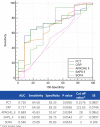An Evaluation of Serum Procalcitonin and C-Reactive Protein Levels as Diagnostic and Prognostic Biomarkers of Severe Sepsis
- PMID: 29967823
- PMCID: PMC5953295
- DOI: 10.1515/jccm-2015-0022
An Evaluation of Serum Procalcitonin and C-Reactive Protein Levels as Diagnostic and Prognostic Biomarkers of Severe Sepsis
Abstract
Background: Recommendations have been made, following the multicenter Surviving Sepsis Campaign study, to standardize the definition of severe sepsis with reference to several parameters such as haemodynamic stability, acid-base balance, bilirubin, creatinine, International Normalized Ratio (INR), urine output and pulmonary functional value of the ratio between arterial oxigen partial pressure and inspiratory oxigen concentration. Procalcitonin (PCT) is considered to be a gold standard biomarker for the inflammatory response, and recent studies have shown that it may help to discover whether a seriously ill person is developing sepsis. C-reactive protein (CRP) is also used as a marker of inflammation in the body, as its blood levels increase if there is any inflammation in the body. The aim of this study was to evaluate serum procalcitonin and C-reactive protein levels as diagnostic and prognostic biomarkers of severe sepsis.
Material and method: Sixty patients, diagnosed as being "septic", were admitted to the intensive care unit (ICU). Based on laboratory results and clinical findings a diagnosis of "severe sepsis" was made, and correlated with PCT and CRP values. The APACHE II, SAPS II and SOFA severity scores were calculated, analyzed and correlated with PCT and CRP.
Results: Fifty two patients (86.67%) presented with criteria for severe sepsis. Multivariate correlation analysis indicated a significant positive association between procalcitonin and all severity scores (APACHEII p<0.0001, SOFA p<0.0001, SAPS II p<0.0001). CRP proved to be significantly correlated only with the SAPS II score (p=0.0145). Mortality rate was high, with 48 patients (80%) dying. There was no significant correlation between the levels of the PCT and CRP biomarkers and severe sepsis (p=0.2059 for PCT, p=0.6059 for CRP).
Conclusions: The procalcitonin levels are highly correlated with the severity scores (APACHE II, SAPS II, SOFA) regularly used in ICUs and therefore can be used for determining the severity of the septic process. Quantitive procalcitonin and C-reactive protein analysis was not shown to be useful in diagnosing severe sepsis. However, PCT and CRP can be used to predict the fatal progression of the septic patient.
Keywords: C-reactive protein; procalcitonin; prognostic biomarkers; severe sepsis.
Conflict of interest statement
Conflict of interest: The authors declare that they have no conflict of interest.
Figures
Similar articles
-
[The correlation between procalcitonin, C-reactive protein and severity scores in patients with sepsis and their value in assessment of prognosis].Zhonghua Wei Zhong Bing Ji Jiu Yi Xue. 2015 Feb;27(2):97-101. doi: 10.3760/cma.j.issn.2095-4352.2015.02.004. Zhonghua Wei Zhong Bing Ji Jiu Yi Xue. 2015. PMID: 25665606 Chinese.
-
A randomized trial to compare procalcitonin and C-reactive protein in assessing severity of sepsis and in guiding antibacterial therapy in Egyptian critically ill patients.Ir J Med Sci. 2021 Nov;190(4):1487-1495. doi: 10.1007/s11845-020-02494-y. Epub 2021 Jan 14. Ir J Med Sci. 2021. PMID: 33447966 Clinical Trial.
-
[Combined prognostic value of serum lactic acid, procalcitonin and severity score for short-term prognosis of septic shock patients].Zhonghua Wei Zhong Bing Ji Jiu Yi Xue. 2021 Mar;33(3):281-285. doi: 10.3760/cma.j.cn121430-20201113-00715. Zhonghua Wei Zhong Bing Ji Jiu Yi Xue. 2021. PMID: 33834968 Chinese.
-
The efficacy of procalcitonin as a biomarker in the management of sepsis: slaying dragons or tilting at windmills?Surg Infect (Larchmt). 2013 Dec;14(6):489-511. doi: 10.1089/sur.2012.028. Epub 2013 Nov 25. Surg Infect (Larchmt). 2013. PMID: 24274059 Review.
-
The Advancement in Detecting Sepsis and Its Outcome: Usefulness of Procalcitonin in Diagnosing Sepsis and Predicting Fatal Outcomes in Patients Admitted to Intensive Care Unit.Cureus. 2021 Apr 12;13(4):e14439. doi: 10.7759/cureus.14439. Cureus. 2021. PMID: 33996303 Free PMC article. Review.
Cited by
-
Adenosine Attenuates LPS-Induced Cardiac Dysfunction by Inhibition of Mitochondrial Function via the ER Pathway.Evid Based Complement Alternat Med. 2019 Jan 10;2019:1832025. doi: 10.1155/2019/1832025. eCollection 2019. Evid Based Complement Alternat Med. 2019. PMID: 30733807 Free PMC article.
-
The utility of procalcitonin for diagnosing bacteremia and bacterial pneumonia in hospitalized oncology patients.J Cancer Res Clin Oncol. 2023 Jul;149(8):5193-5204. doi: 10.1007/s00432-022-04419-x. Epub 2022 Nov 13. J Cancer Res Clin Oncol. 2023. PMID: 36371720 Free PMC article.
-
A Comparative Review of Equine SIRS, Sepsis, and Neutrophils.Front Vet Sci. 2019 Mar 12;6:69. doi: 10.3389/fvets.2019.00069. eCollection 2019. Front Vet Sci. 2019. PMID: 30931316 Free PMC article. Review.
-
Investigating Morphological Changes of T-lymphocytes after Exposure with Bacterial Determinants for Early Detection of Septic Conditions.Microorganisms. 2022 Feb 8;10(2):391. doi: 10.3390/microorganisms10020391. Microorganisms. 2022. PMID: 35208846 Free PMC article.
-
Sepsis-Associated Coagulopathy.J Crit Care Med (Targu Mures). 2016 Nov 8;2(4):156-163. doi: 10.1515/jccm-2016-0024. eCollection 2016 Oct. J Crit Care Med (Targu Mures). 2016. PMID: 29967855 Free PMC article.
References
-
- Angus DC, Linde-Zwirble WT, Lidicker J. et al. Epidemiology of severe sepsis in the United States: Analysis of incidence, outcome, and associated costs of care. Crit Care Med. 2001(29):1303–10. - PubMed
-
- Dellinger RP.. Cardiovascular management of septic shock. Crit Care Med. 2003(31):946–55. - PubMed
-
- Bone R, Balk R, Cerra F. et al. Definitions for sepsisand organ failure and guidelines for the use of innovative therapies in sepsis. The ACCP/SCCM Consensus Conference Committee. American College of ChestPhysicians / Society of Critical Care Medicine”. Chest. 1992(101):1644–55. - PubMed
-
- Hervald H, Egesten A.. Sepsis. Pro-Inflammatory and Anti-Inflammatory Responses. Controb Microbiol. Basel, Krager. 2011;17:1–11.
LinkOut - more resources
Full Text Sources
Other Literature Sources
Research Materials
Miscellaneous


